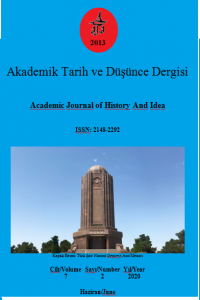Geç Dönem Osmanlı Eğitiminin Dinamiklerini Halide Edib’in Mor Salkımlı Evi’nden Okumak
Bu çalışmada Meşrutiyet ve Cumhuriyet devirlerinin tanınmış edebiyatçılarından Halide Edib Adıvar(1882-1964)’ın “Mor Salkımlı Ev” başlıklı otobiyografisinden yola çıkılarak Halide Edib’in eğitim geçmişinden istifadeyle geç dönem Osmanlı eğitimi aydınlatılmaya çalışılmaktadır. İlgili yazarın aile bireyleri, kitap(dinî ve dinî olmayan), tiyatro ve tabii ki öğretmenleri ve okul arkadaşlarına kadar çok çeşitli yerlerden etkilendiği görülmektedir. Bu çeşitli etkilerin o dönemde mevcut olan eğitim seçenekleriyle paralellik arz ettiği de görülmektedir. Yabancı ya da yerli, resmi veya gayri resmi(örneğin evde) eğitim, bizzat eğitimin içinde yer alma vb. hususlara bir bütün olarak bakıldığında ilgili kaynağın geleneksel olarak resmi okul sistemi perspektifinden bakılmış olan eğitim tarihinin bazı başlıklarını doldurmaya yardımcı olduğu da görülmektedir.
Anahtar Kelimeler:
Osmanlı Devleti, Halide Edib, Eğitim, Ottoman Empire, Education
Reading The Dynamics Of Late Ottoman Education From Mor Salkımlı Ev (House Wıth Wısterıa) By Halide Edib
In this study, it is tried to illuminate the late Ottoman education by making use of Halide Edib’s educational background, based on the autobiography of Halide Edib Adıvar(1882-1964), one of the well-known men of letters of the Constitutional and Republican eras, titled “House with Wisteria”. The author seems to have been influenced by a wide variety of places, from family members, books(religious and non-religious), theater, and of course, to her teachers and schoolmates. It is also seen that these various effects are in parallel with the education options available at that time. When the issues such as foreign or domestic, formal or informal education(for example, at home), taking part in education itself are considered as a whole, it is seen that the relevant resource helps to fill some headings of the history of education that have traditionally been viewed from the perspective of the official school system.
Keywords:
Ottoman Empire, Halide Edib, Education,
- Yayın Aralığı: Yılda 6 Sayı
- Başlangıç: 2013
- Yayıncı: Hakan YILMAZ
Sayıdaki Diğer Makaleler
Kültepe’den Amūtum İşlemeli Altın Kadeh
Sinop’ta Geleneksel Ahşap Köy Camileri
Çukurova Türkmenlerinin Son İskânı
СУЕВЕРИЯ В РУССКОЙ ЛИНГВОКУЛЬТУРЕ
Siyonizm’in Doğuşuyla Ortaya Çıkan İsrail-Filistin Sorunu: Arap-İsrail Savaşlarının Hüzün Sonu
Düzeltme: Rusya’da Esir Bir Yedek Subay Halil Ataman
Əxlaqi Və Hüquqi Şüurun Mənayaradıcı İdeyaları
Rüya Olgusu Dini ve Psikolojik Yansımaları
Geç Dönem Osmanlı Eğitiminin Dinamiklerini Halide Edib’in Mor Salkımlı Evi’nden Okumak
